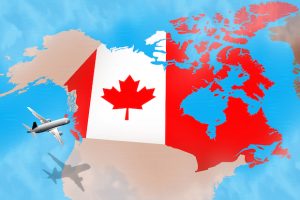Looking for a flight to Amsterdam? Start typing AMS and you'll see the airport pop right up in the search field. How about Miami? Punch in MIA and you’re good to go. Montreal? Enter MON or MTL and… and… hmm, what’s up with that, eh? YUL soon find out that the international's code for Montreal’s main airport, Pierre Elliott Trudeau, doesn’t even start with the letter M. Montreal isn't the only Canadian city that doesn't seem to match up with its three-letter identifier. While there are a handful of cities with strange airport codes, many which I’ve explained here, there’s something unique about Canadian airports – they all seem to start with the letter Y.
Canadian Airport Codes Explained
From Halifax, which is YHZ, to Saskatoon’s YXE, and Toronto’s two airports that will leave you scratching your head (YYZ and YTZ), it’s easy to get befuddled when figuring out which Canadian airport is which. So how and why did they come up with these confusing airport code identifiers? The story is just as complicated as the codes themselves, but like most things in Canada it all comes down to the weather.
Prior to the formation of the IATA, International Air Transport Authority, (which just so happens to be headquartered in Montréal), Canada identified its weather towers with two-letter call signs. These two-letter indicators tied to the local weather towers were often situated in locations that housed airports along with radio stations. The call signs doubled as Morse code transmissions for pilots to use a navigational beacon to locate the airport. For example, at the time Montréal-Dorval’s radio call sign happened to be UL.
As air travel increased in the 1930s, it was important to identify if an airport had a weather/radio station located on its premises for safety and landing reasons. If it did, the letter Y for “yes” was added in front of the existing radio call sign. If there were no weather stations at the airport, a W would be administered for "without." Combining the Y from Yes and the UL radio station code, YUL was born.
When IATA formed and began requiring airports worldwide to extend their codes to three-letters (as two-letter codes were becoming scarce) during the 1940s, most of Canada’s airports had already adopted the Y for “yes” prefix due to their weather reporting and radio stations located on site.
Already familiar with the Y initial indicating an airport via its radio tower beacon system, Canada made the bold move to lay claim to the letter. Snatching it up to signify all of its airports in a uniform fashion. By saying yes to the Y, Canada firmly aligned all its commercial airports with the same letter making it the only major country to assign IATA codes in this style.
What about The Remaining Letters of the IATA Code?
Using the YUL logic above, all Canadian airports should start with the letter Y followed by the existing radio call sign, right? Nope, that’d be too easy.
While some Canadian IATA codes follow in that footprint like Toronto’s YYZ airport, which uses the radio code for the city of Malton where it’s located, others follow different naming patterns.
As air travel grew in popularity and the requirement to assign airports three-letter IATA codes, many cities didn’t have the aforementioned weather stations. In these instances, cities used railways station codes, which also used a two-letter Morse code indicator.
Edmonton, who's railway code of EG, morphed into YEG when its IATA code got assigned. Using railway station codes as opposed to radio tower identifiers allowed for many Canadian airports to form almost recognizable airport codes. YVR, minus the Y leaves VR – easier to decipher into VancouveR. The same goes for YOW, Y + OttaWa, and YQB, Y + QuéBec. Albeit confusing, that's loosely the method on how Canada created most of its cryptic and confounding IATA airport codes.
Other Tidbits on Y Airport Codes
To further confuse the flying masses, metropolitan areas with several airports can also be searched under umbrella IATA codes. Like in Toronto where YTO includes both YYZ and YTZ as results. The Y, of course, comes as expected and the TO short for Toronto. The same for YMQ, where MQ = Montréal, Québec. This metropolitan naming method isn't just inherent to Canada. Tokyo uses TYO to encompass both Narita (NRT) and Haneda (HND) airports. And NYC is used for all New York City area airports including Newark (EWR). But what does makes Canada unique in this instance is that even “city codes” that serve several airports follow along with the Y as the first initial pattern. So if you ever happen to notice your bag tagged with YMQ, you’re in trouble because no airport under that IATA code actually exists.
Even though Canada has the majority of the world’s airport codes beginning with the letter Y, they don’t have a monopoly on all of them. Just ask the locals from Yakima, Washington (YKM) and Yuma, Arizona (YUM) if they know the verses to "O Canada".
For the nitpickers out there, it’s also worth noting that not every airport in Canada starts with the letter Y either. Many smaller municipal airports, heliports, and private jet runways have codes beginning with other letters of the alphabet (Mostly W (previously explained: Without ), X or Z). All large-scale commercial airports, however, will start with an IATA code of Y.
Now that you know how Canadian airports adopted their IATA codes. Y not have a look at our current flight deals to cities across the Great White North.
Toronto (YYZ) - Vancouver (YVR) - Montréal (YUL) - Calgary (YYC)
Ottawa (YOW) - Edmonton (YEG) - Halifax (YHZ) - Winnipeg (YWG)
Victoria (YYJ) - Kelowna (YLW) - Québec City (YQB) - Saskatoon (YXE)






